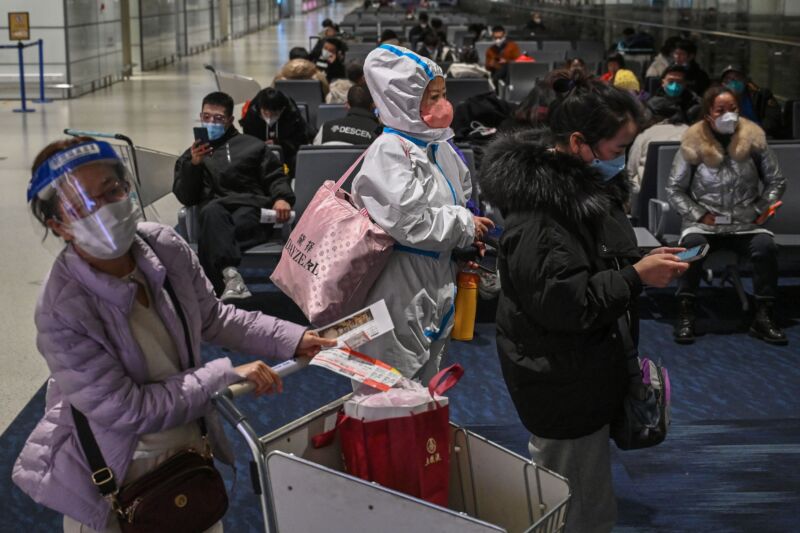Another reminder to keep those masks on during flights.
Although China has largely abandoned COVID-19 case reporting, evidence of its massive wave of infection readily shows up in airports outside its borders.
On a December 26 flight from the southeastern city of Wenzhou to Milan, Italy, 42 percent of the 149 passengers on board tested positive for COVID-19 upon arrival, according to a study published Thursday in the journal Eurosurveillance.
The Italian researchers behind the study also looked at test-positivity rates of three other flights from eastern cities in China to Italy, two to Milan and two to Rome, all at the end of December. Collectively, 23 percent of the passengers from the four flights (126 of 556 passengers) were positive for SARS-CoV-2. The other three flights had positivity rates of 19 percent, 11 percent, and 14 percent.
The passengers were tested either with rapid-antigen tests or PCR tests. Positive antigen tests were confirmed with PCR tests. The testing most likely captured people with mild or asymptomatic cases, as well as those who had recently recovered. PCR tests can remain positive for weeks following an infection.
Similar to the Italian data, The Washington Post reported about a week ago that it had seen data from the Korea Disease Control and Prevention Agency indicating that 23 percent of short-term visitors from China to Korea (314 out of 1,352 tested at the airport) were positive for SARS-CoV-2 between January 2 and 6.
The rates betray mass infection in China, which is expected, but not well documented. When China abruptly scrapped its zero-COVID policy last month, it ditched mass testing and largely gave up reporting cases. Meanwhile, the virus has been ripping through a population that is, as the Italian researchers note, "a highly vaccinated but infection-naïve population."
Current models estimate that there could be 1.5 million new infections daily in China, and over 1 million could die in the coming weeks. Health experts are particularly concerned about the spread of disease amid the upcoming Lunar New Year on January 22, when tens of millions of people in China travel to see family for the festivities. The movement is expected to shift high transmission from big cities to more vulnerable rural areas.
Benjamin Cowling, an epidemiologist at the University of Hong Kong, told The Washington Post that the infection rates so far are "completely consistent with forecasts that the majority of the population of major cities have already been infected."
One point of good news is that the Italian researchers did whole genome sequencing of the virus from 61 passengers and, in that sampling, did not find any new or alarming variants. The sampling turned up omicron sublineages BA.5.2, BF.7, and BQ.1.1, which have been seen elsewhere. The data matches what has been reported elsewhere and from China.
- aum
-

 1
1




Recommended Comments
There are no comments to display.
Join the conversation
You can post now and register later. If you have an account, sign in now to post with your account.
Note: Your post will require moderator approval before it will be visible.